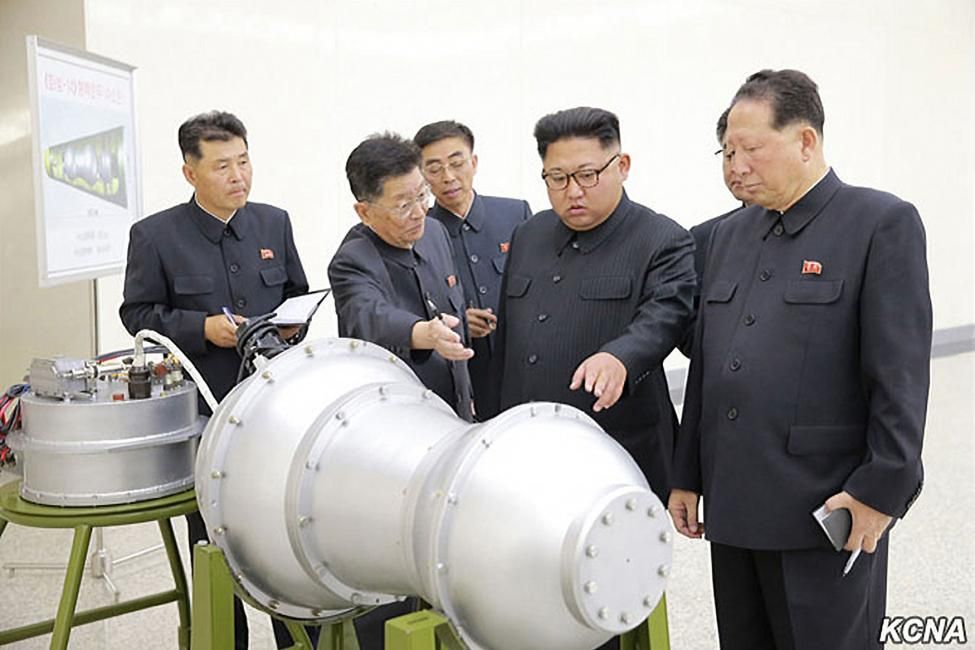How to tell if North Korea is serious about denuclearization
By Duyeon Kim | October 29, 2018
 Scientists briefing North Korean leader Kim Jong-un in a photo released in 2017 Credit: Korean Central News Agency.
Scientists briefing North Korean leader Kim Jong-un in a photo released in 2017 Credit: Korean Central News Agency.
Since the Singapore summit between US President Donald Trump and North Korean leader Kim Jong-un in June, Pyongyang has made gestures and statements suggesting that it will curtail its nuclear-missile programs. However, in the absence of a nuclear deal between Washington and Pyongyang, the North’s nuclear arsenal continues to expand, and the regime continues to violate UN Security Council Resolutions that prohibit nuclear and missile-related activities.
With preparations for a second Trump-Kim summit underway, how should the international community determine what initial denuclearization steps really count? As Washington and Seoul engage with North Korea diplomatically, they have a rare opportunity to persuade the regime that surrendering its nuclear weapons and programs will in fact lead to a brighter future and eventual peace on the Korean Peninsula. But observers need to distinguish steps that are symbolic at best from those that demonstrate Pyongyang’s seriousness. Grabbing hold of whatever Pyongyang offers indiscriminately will only weaken Washington’s future negotiating position.
Before deciding what does constitute a meaningful or serious offer from North Korea, it is helpful to consider what does not. The broad targets of North Korea’s denuclearization should include: the regime’s fissile and thermonuclear material production programs, its nuclear weaponization program, its nuclear weapons and related missiles and other delivery systems, its proliferation programs, and its illicit trade and smuggling networks. Each element is comprised of various facilities, materials, and technologies. With that level of complexity, North Korea could divide each target into multiple steps to offer as bargaining chips, a tactic known as “salami slicing.” And while some initial steps in isolation may be noteworthy or even meaningful, they could actually become relatively meaningless depending on the context.
How to measure seriousness. For instance, Kim Jong-un declared in December last year that his state nuclear force was complete, meaning the regime no longer needed to test parts. This explains why, in his New Year’s Day address, he ordered his nuclear establishment to mass produce and deploy nuclear warheads and ballistic missiles, claiming their “power and credibility are already guaranteed.” He then said in his report to the Workers’ Party Central Committee plenum (a meeting of the Party’s chief policymaking body) in April that the country’s nuclear and missile testing, along with associated sites, had served their intended purpose and were no longer needed. In short, before applauding the regime for pronouncements that sound like meaningful denuclearization measures, observers should consider what value North Korea places on certain facilities and parts of its nuclear and missile programs.
North Korea has offered to take a number of steps that cost it nothing or involve facilities it does not need anymore, for example: A moratorium on nuclear and missile testing, the destruction of the entrance to the Punggye-ri nuclear test site, and the dismantlement of the Tongchang-ri missile engine test facility. These might serve as symbolic measures to help maintain a positive atmosphere during nuclear diplomacy, but they do not signal a serious intent to denuclearize.
Another overture Washington shouldn’t overvalue is Pyongyang’s offer at September’s inter-Korean summit to allow experts into its Yongbyon nuclear complex and to dismantle it, “depending on Washington’s corresponding measures.” (Many observers took “corresponding measures” to mean a declaration officially ending the Korean War.) While scrapping Yongbyon would not be entirely meaningless, the offer does not reflect a serious intent to denuclearize, as it is widely believed that the real engines of the North’s nuclear-missile programs are elsewhere. Nor is it clear which facilities and materials at Yongbyon North Korea would be willing to eliminate.
For the purpose of negotiations, American policymakers will need to determine whether the value of any offer from Pyongyang is proportionate to its asking price. North Korea’s technological advancements have armed it with confidence and leverage in talks. A denuclearization step might be meaningful on its own, but still not make a smart tradeoff if the North demands more than it offers. Giving away too much will make future tradeoffs more difficult as Washington quickly runs out of cards to play. In declining to provide a nuclear inventory and instead making the conditional Yongbyon offer, it appears that Pyongyang is trying to extend the negotiation process and take as much as it can along the way.
History also provides some context for determining whether North Korea is making serious progress on denuclearization. Between 2003 and 2008, during the George W. Bush administration, North Korea participated in the Six Party Talks with the United States, South Korea, China, Japan, and Russia. As a result of those talks, North Korea shut down and froze its nuclear activities, disabled key plutonium-producing facilities at the Yongbyon nuclear complex, and submitted a nuclear inventory. At the time, the North’s plutonium program was considered the most urgent threat, and negotiators deferred the country’s uranium program to an unspecified date. The talks broke down over disagreements on a verification protocol, particularly over Pyongyang’s opposition to environmental sampling, and time ran out before they could negotiate what the final dismantlement stage would look like. A good benchmark now would be to look for steps from North Korea that go beyond those taken during the Six Party Talks, in particular submitting a nuclear inventory that includes its uranium program and facilities outside of Yongbyon, and agreeing on a verification protocol. More steps and details would certainly be better. Pyongyang’s uranium program is a more urgent problem now than it was back then, and believed to be underway in facilities hidden outside of Yongbyon.
Concrete steps to look for. Using these metrics, there are initial steps Pyongyang could take to signal its seriousness. First, it could agree on a comprehensive and detailed denuclearization roadmap, complete with milestones and timetables, which would presumably include concessions the regime actually considers valuable and a plan for the dismantlement phase the Six Party Talks never negotiated. Washington would have to agree on what to give in return regarding the various components of a peace process and normalization of bilateral relations, and when to give them. The roadmap would provide Washington and the international community with some degree of confidence that the regime might be willing to embark on a process to eventually eliminate its nuclear weapons and programs.
Second, if North Korea were to submit a nuclear inventory, this would deserve a nod from the international community—though perhaps not quite applause, because Pyongyang did submit an inventory once before, during the Six Party Talks, so doing so again only gets us back to where we were a decade ago. Experts disagree about what should be included in a new inventory. The best-case scenario would be a comprehensive list of all targets for denuclearization, among them warheads, missiles, storage sites, and more. But realistically, Pyongyang is unlikely to declare everything at once. Washington should insist on an initial list of all facilities, materials, and stockpiles related to the nuclear fuel cycle as a starting point, and negotiate for more details in the next phases. If an initial list goes beyond these components, it would further increase confidence about Pyongyang’s seriousness.
Third, verifiably halting the production of all fissile material—uranium and plutonium, nuclear weapons’ key ingredients—would be a significant signal of seriousness. Going further by disabling these facilities would be even better. Washington has understandably focused much of its attention on halting the development of inter-continental ballistic missiles because they could reach the US mainland, but an ICBM without a nuclear warhead serves no real strategic purpose for the North.
Finally, Pyongyang could demonstrate a serious intent to denuclearize by agreeing to a verification protocol, something that has not been achieved in past negotiations. Inspections and verifications confirm the accuracy of a nuclear inventory and claims about nuclear programs. (Later on, these procedures would verify that nuclear-missile activities have stopped, programs remain offline, and facilities are not being rebuilt). Verification is the kiss of death for a heavily-controlled regime like North Korea. It believes that transparency undermines national sovereignty and reveals state secrets, and might even be embarrassed if its actual nuclear-missile technology is not as sophisticated as it has claimed. It is also unclear where Pyongyang would allow inspections and verification activities to take place, who would do them, and whether they could even be conducted properly. For these reasons, it is unlikely that North Korea would agree to a verification protocol soon, and if it eventually does, it would be tough to negotiate.
It is not that lesser actions deserve no recognition. Every verifiable step toward eliminating key facilities, materials, and weapons in return for proportionate US concessions can help incentivize both sides to stay engaged in the negotiating process. But only certain actions should be understood as genuine North Korean commitments to eventual denuclearization when taken into context. Being able to discern which concessions are meaningful and serious will help US negotiators gauge whether to pocket them, and how to offer balanced tradeoffs.
Editor’s note: Duyeon Kim’s research is supported by the John D. and Catherine T. MacArthur Foundation.
Together, we make the world safer.
The Bulletin elevates expert voices above the noise. But as an independent nonprofit organization, our operations depend on the support of readers like you. Help us continue to deliver quality journalism that holds leaders accountable. Your support of our work at any level is important. In return, we promise our coverage will be understandable, influential, vigilant, solution-oriented, and fair-minded. Together we can make a difference.
Topics: Columnists, Nuclear Weapons















Ms. Kim’s analysis of what might constitute serious “denuclearization” steps by North Korea would be quite useful if the issue was unilateral disarmament of the North. Quite clearly though the context of negotiations is “denuclearization of the peninsula” which includes changes in the military postures of South Korea and the United States. At this early stage of negotiations North Korea, South Korea, and the U.S. are assiduously avoiding discussing these important complicating factors, yet productive discussions about “peninsular disarmament” will determine whether there will eventually be denuclearization of North Korea. We can not expect North Korea to give up nuclear… Read more »